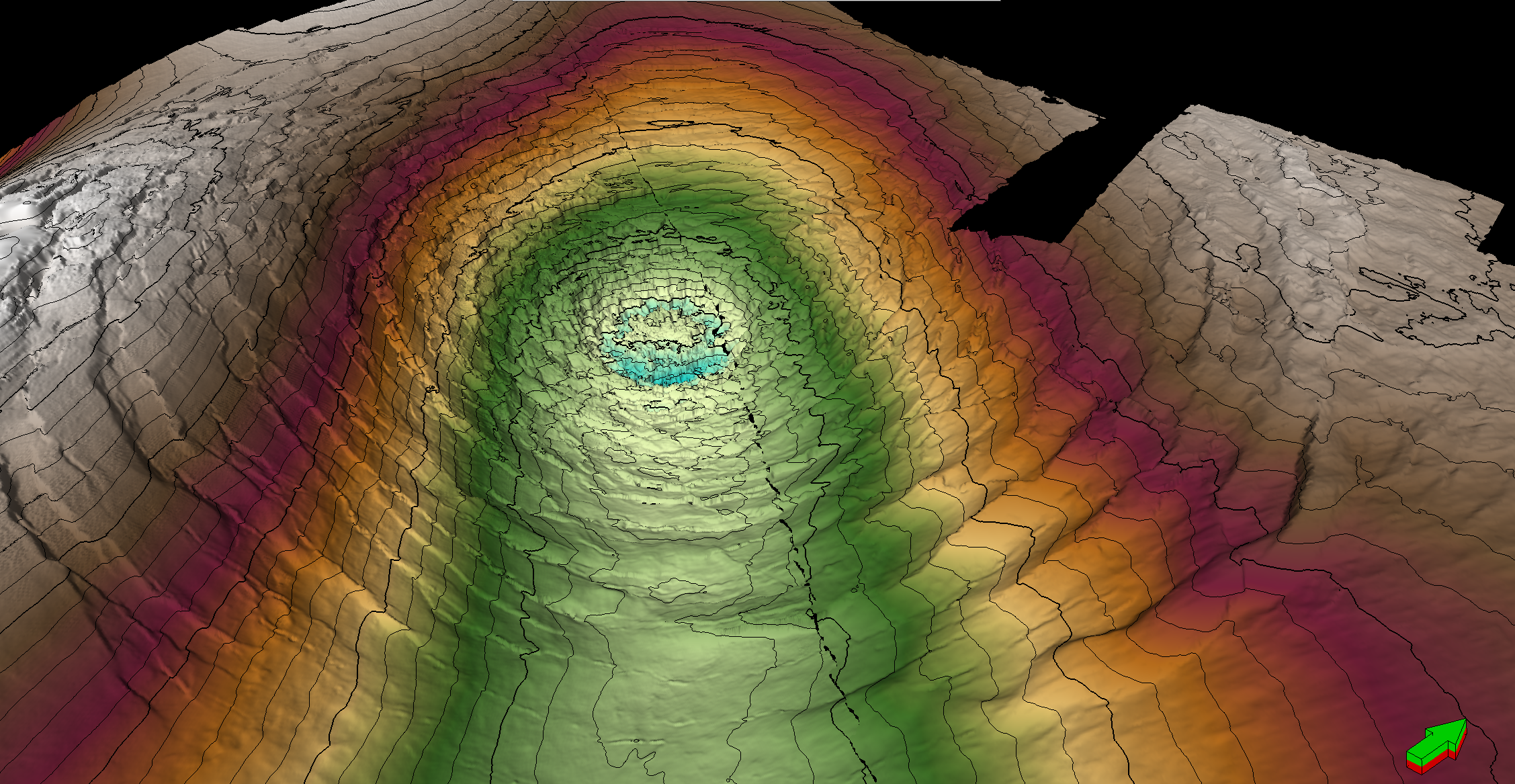The Silver Bullet for Silverpit Crater: solving a 20-year-old geological controversy.
Published in Earth & Environment
Discovery and debate
Silverpit Crater has been the subject of a major debate since its discovery over two decades ago. The crater was first identified using seismic reflection data in the early 2000s, with the data first published in a Nature paper in 2002 1. However, an extraterrestrial origin was contested in the same journal 2, with a series of papers building on that suggesting more mundane, ‘earthy’ explanations for the crater, including the movement of salt deep beneath the seafloor, and volcanic eruptions of a similar age.
This led to a famous debate at the Geological Society of London in 2009. After both sides made their case, the audience was asked to vote for or against an impact origin. Unequivocally, “the nays had it” – the vast majority of the audience (who happened to be mostly petroleum geologists, according the Geological Society report 3) voted against an impact origin. For many, that was the final word. Debate over the crater faded into the background, with little motivation for anyone to look at this crater again.

The nays have it: the audience at the Geological Society debate overwhelmingly votes for a non-impact origin. https://www.geolsoc.org.uk/Geoscientist/Archive/December-2009/Silverpit-not-crater
Resurrecting the crater, 20 years later
Two decades later, in late 2022, we stumbled into this controversy by virtue of another high-profile crater story. We had just published our first paper on the discovery of an intriguing new impact structure offshore West Africa that is close in age to the dinosaur-killing event at the end of the Cretaceous Period (66 million years ago) 4. This created a lot of media interest, and we were getting numerous emails at the time, mostly from amateur enthusiasts suggesting that various circular features could be craters. I received one particularly intriguing email, from Ron Parr at the North Sea Transition Authority, regarding Silverpit Crater. That, too, had been originally proposed as a near-end-Cretaceous crater 1, as the most prominent circular faults surrounding the crater were in the brittle chalk deposits that had originally been deposited in the warm seas of the Late Cretaceous.
I had been aware of the controversy around Silverpit but had never looked at the actual seismic data itself. I must admit that I had bought into the prevailing wisdom that the structure had a much more mundane origin, and that the evidence was stacked against it. However, we had access to the old seismic data, and we decided to take a look.
When we saw the data, it seemed that the evidence for an impact structure was really quite compelling – the circular fault patterns surrounding a donut-like moat and a dome (‘central uplift’) below the crater floor. The latter feature in particular is characteristic of so-called ‘complex craters’, where the acoustic energy of the impact is so extreme and the rocks below the seabed shaking so violently that they temporarily flow like a viscous fluid into the cavity caused by impact.
This was intriguing, and we started looking back at the old papers that had argued for and against an impact origin. The arguments against an impact origin hinged around the ambiguity of seismic imaging around the central uplift in particular (the 3D seismic was stitched together from a patchwork of surveys), and alternative geological processes– salt movement and magmatism most prominently. But we weren’t convinced on either count – the geophysical images did not look like artefacts, and the geological explanations didn’t seem to fully explain this unique feature. More than that – it looked remarkably similar to the 3D data across the Nadir Crater that we were working on at the time 5.
We were quite excited by the prospect of revisiting Silverpit, but it was clear that we would need some new data, and new approaches, to test the impact crater hypothesis. Ron let me know that some new, high-resolution 3D seismic data had been acquired by Nothern Endurance Partnership (NEP) for deep CO2 storage, that might shed some more light on this. This data extended across the controversial central uplift as well as some of the data gaps in the original surveys. I approached them to see if they would be willing to share this, and collaborate on the project.
At the same time, we decided to sample the drill cuttings (small rock chips) that had come from an old exploration well drilled at the northwest of the crater to see if we could find any direct evidence of impact – quartz or felspar grains with evidence of “shock metamorphism”. These samples could also help us to constrain the precise age of the crater. And finally, my colleague Gareth Collins ran some new numerical impact simulations to see if we could replicate the impact structure, and therefore the size and energy of the impactor.
The evidence mounts…
When we received the seismic data, it immediately dispelled any questions about seismic artefacts – the central uplift and moat are real geological features. But it also gave us a much clearer image of the crater and the surrounding seabed. It revealed a complex set of geological structures that are quite clearly not linked to any other process. It also revealed some really truly unique characteristics, not seen on any other terrestrial structure, including secondary craters formed from blocks of rock blasted out of the crater.
We could also see a series of enigmatic half-kilometre scale pits in the central uplift that we believe formed because of a secondary eruption of gas from below the crater floor. This was likely a result of the chalk below the crater floor being instantaneously baked, producing a huge amount of carbon dioxide that was catastrophically release. This was all consistent with the results of the computer simulations that we were generating at Imperial College.

3D image of the top chalk, below the Silverpit Crater, showing concentric faults around the donut-like moat and central uplift, characteristic of complex impact craters.
Even though this data was compelling in its own right, we were missing one key piece of evidence – the equivalent of the DNA for an impact event – that could definitely prove that this occurred because of impact. To do this, we sampled all of the rock chips from the nearby well, across an interval of several hundred metres above and below the crater floor. At the first attempt, we failed to find any direct evidence of the shocked mineral grains that we were looking for. This was disappointing, but not surprising – this was a real ‘needle-in-a-haystack’ approach, given that the samples were only collected every 6 m or so, and we expected the ‘ejecta’ layer from the impact to be much thinner.
However, we did find one sample, of Eocene age (about 45 million years old) at 494 m below the seabed, that was full of strange, amorphous, carbonate grains that we couldn’t easily explain. This also happened to be our best estimate of the depth of the seabed at the time of impact. I asked Thomas Kenkmann, who was analysing the minerals for evidence of shock, if he could make another set of samples from this depth and take one more look. And, at the second attempt, we struck gold. Thomas found a compelling set of shocked minerals in that sample (as well as one, slightly shallower, sample, which we think was reworked by waves). This was it – the ‘silver bullet’ that had been missing for many years!

The Silver Bullet: shocked quartz and feldspar grains proving an impact origin.
An impact origin confirmed
All of this evidence clearly points to an impact origin for this enigmatic feature, that has been debated for so many years. We can now say with confidence that the structure formed because of an asteroid (or possibly a comet) of around 160 m diameter, that hit the North Sea around 45 million years ago. This exceptionally preserved structure can continue to provide important information on what happened during this specific event, but also what might happen if a similar event were to occur in the future.
- Stewart, S., Allen, P. A 20-km-diameter multi-ringed impact structure in the North Sea. Nature 418, 520–523 (2002). https://doi.org/10.1038/nature00914
- Underhill, J. An alternative origin for the ‘Silverpit crater’. Nature 428, 1–2 (2004). https://doi.org/10.1038/nature02476
- https://geoscientist.online/wp-content/uploads/2025/07/Geoscientist-2009_19_12-December.pdf
- Nicholson, U., et al. The Nadir Crater offshore West Africa: A candidate Cretaceous-Paleogene impact structure.Sci. Adv.8,eabn3096(2022). DOI:10.1126/sciadv.abn3096
- Nicholson, U., Powell, W., Gulick, S. et al.3D anatomy of the Cretaceous–Paleogene age Nadir Crater. Commun Earth Environ5, 547 (2024). https://doi.org/10.1038/s43247-024-01700-4
Follow the Topic
-
Nature Communications

An open access, multidisciplinary journal dedicated to publishing high-quality research in all areas of the biological, health, physical, chemical and Earth sciences.
Related Collections
With Collections, you can get published faster and increase your visibility.
Clinical trials 2025
Publishing Model: Open Access
Deadline: Dec 31, 2025
Women's Health
Publishing Model: Hybrid
Deadline: Ongoing

Please sign in or register for FREE
If you are a registered user on Research Communities by Springer Nature, please sign in